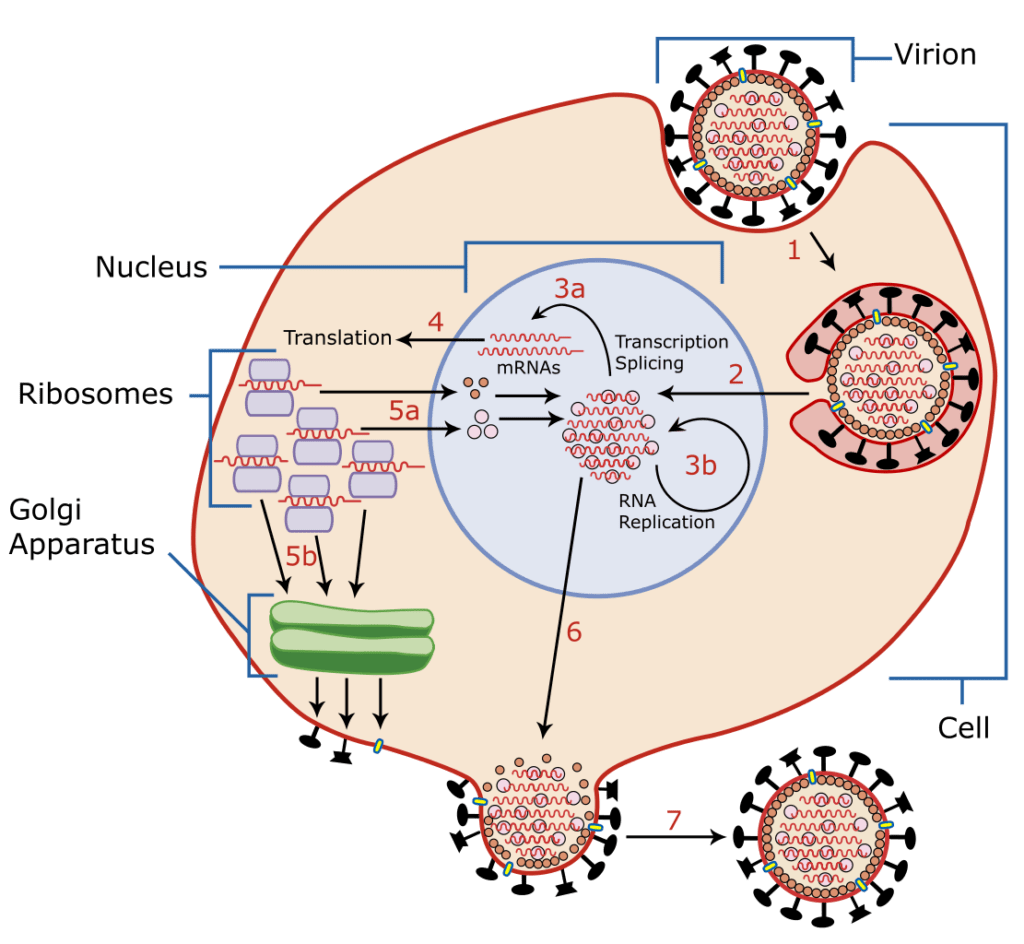Viruses are obligate intracellular parasites. They only reproduced in the host cell. Viruses lack the enzymes for their replication. it uses the metabolic machinery of the host cell for its replication. Isolated viruses are only protein-coated particles. They are transmitted from one host to another.

Host Range
Each type of virus can infect only a short range of Hosts. It is called its Host range. viruses identify their host by a lock-and-key. There are specific receptor molecules on the host cell. Similarly, some proteins are present on the surface of the virus. These receptors and proteins take place in the lock-and-key attachment. Some viruses have broad host ranges. They infect several species of host. For example, the rabies virus can affect the number of species has a narrow host range. They infect only single species. For example, the phage virus infects only E. coli bacteria.
There are the following stages of infection and replication of viruses:
Penetration
It is the primary step of infection, Mechanism of penetration is different in several species. For example, Phage uses its tail apparatus to inject DNA into the bacterium. Their tails have a special enzyme Lysozyme. It breaks the cell wall and cell membrane of the bacterium. In some cases, complete virion inters into host like AIDS virus.
Replication
Viral DNA takes under control the metabolic machinery of the host cell. It reprograms the viral genes and manufactures its capsids. Most DNA viruses use the DNA polymerase of the host cell to synthesize its new DNA. RNA viruses contain enzymes to initiate replication in the host cell. The host has no enzyme to copy RNA.
The virus uses the resources of the host for viral production. The host provides the nucleotides for nucleic acid synthesis. The virus uses host enzymes, ribosomes, tRNA, amino acids, and other machinery.
Assembly of Virion
Viral nucleic acid molecules and capsids are produced. Their assembly into new viruses is a spontaneous process. Their process is called Self-assembly. RNA and capsomeres of TMV can be separated into the laboratory. If its contents are mixed spontaneously reassemble it.
Release of Virions
Hundred or thousands of viruses emerge from the host cell. The host cell is mostly destroyed in small pieces in this process. The destruction of the host cell causes some symptoms of viral disease. For example, cold, corona and influenza viruses destroy the mucous membrane in respiratory passages. It causes symptoms of cold and influenza. The newly-formed viruses start infecting other cells and in this way, a new cycle started.
Coronavirus

Structure
coronavirus has a spherical virion with a diameter of 125 nm according to the latest study. It has club-shaped spikes that appear on the surface of the virion. These spikes are defining features of virion giving it the name Coronavirus. Coronavirus has helical nucleocapsid that is uncommon for the positive-sense RNA viruses but common to negative-sense viruses.
replication
The primary attachment to the host cell starts with the interaction between the S protein and its receptor. In the S1 region, the receptor-binding domain of a Coronavirus S protein varies depending on the virus, like some have RBD at the N-terminus of S1 while others at the C-terminus of S1.
The replication takes place by encoding genes into two large ORFS,
- rep1a
- rep1b
Which show two co-terminal polyproteins:
- pp1a
- pp1ab
virions are transported to the cell surface in vesicle form and released takes place by exocytosis. it’s not known if the virions use the normal pathway for transport of huge cargo from the Golgi or if the virus has diverted a separate, unique pathway for its own exit.



